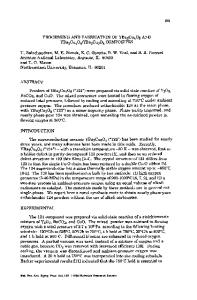Synthesis and Properties of Ultra-Thin YBa 2 Cu 3 O7 and YBa 2 Cu 3 O 7 /La 2-x Sr x CuO 4 Multilayers
- PDF / 1,231,564 Bytes
- 4 Pages / 420.48 x 639 pts Page_size
- 95 Downloads / 356 Views
SYNTHESIS AND PROPERTIES OF ULTRA-THIN YBa2Cu3O7 AND YBa 2 Cu30 7 /La2 .xSrxCuO 4 MULTILAYERS C.B. EOM, S.K. STREIFFER, J.Z. SUN, K.YAMAMOTO, S.S. LADERMAN*, J.C. BRAVMAN, and T.H. GEBALLE Stanford University, Stanford, CA 94305 *Hewlett-Packard Co., Palo Alto, CA94304 ABSTRACT Using our standard single target off-axis sputter deposition procedure[I], ultra-thin YBa2Cu 3 O 7 superconducting films were made in-situ. We have studied the thickness dependence of superconducting properties (Tc, Jc) from 20 to 5000A. Tc starts degrading below 125A and falls to 50 K for the 30 A film. Jc drops linearly with decreasing thickness below 1000A.
We have grown YBa2Cu3O7/La2.xSrxCuO4 superconducting thin film multilayers in-situ by the same process. The modulation wavelength of the multilayers ranged from 45A to 2000A. X-ray diffraction and cross sectional TEM confirm the superlattice periodicity. The superconducting transition temperature drops in much the same way as the single layer ultra-thin films. Both the critical current density and its magnetic field dependence decrease as the modulation wavelength decreases.
We report results on ultra-thin YBa 2 Cu 30 7 (YBCO) and YBa2Cu 3O7 /La2_,SrxCuO4 (YBCO/LSCO) multilyered thin films grown in-situ using an off-axis single target magnetron sputtering technique[1 ] that reproducibly exhibit novel physical and materials properties. In order to increase our understanding of the growth mechanism and the effect of interfaces and proximity layers we have undertaken a study of ultra-thin and multilayered films. We have investigated the structural, normal state and superconducting properties. Substrates were placed on the side of a planar magnetron gun in such a way as to obtain a large area of film with the same composition as the target. The superconducting and structural properties of the single layer YBCO films have been described in a previous report. 11 ] The sputtering geometry and sputtering parameters for the multilayers are similar to the standard offaxis procedure except we now use two sputter guns and a computer controlled rotating substrate block. The sputtering atmosphere consisted of 10-60mTorr 02 and 40 mTorr Ar. The rf-power (125 W) on the sputter guns generated a self-bias of 50V for YBCO and 125V for LSCO, which gave a deposition rate of 0.2-0.5 A/sec depending on the pressure. Film thicknesses varied from 20 to 5000
A.
The substrate block temperature was held between 640-720 C.
Substrate materials were SrTiO3(100), LaAIO3(100), and MgO(100). The x-values of 0 and 0.15 were used for the La2.xSrxCuO4 part. Fig. 1. shows the resistive transition of YBCO thin films of various thickness on MgO(100) substrates.
Although Tc starts degrading below 125
Mat. Res. Soc. Symp. Proc. Vol. 169. c1990 Materials Research Society
A,
the full transition
558
temperature of 30 A film was still 50 *K. Resistivities and transition widths also increase with decreasing thickness below 125 A. We have measured critical current densities by a vibrating sample magnetometer at 4.2 K in
Data Loading...











